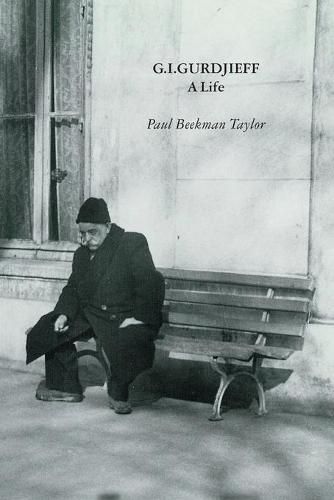Readings Newsletter
Become a Readings Member to make your shopping experience even easier.
Sign in or sign up for free!
You’re not far away from qualifying for FREE standard shipping within Australia
You’ve qualified for FREE standard shipping within Australia
The cart is loading…






This title is printed to order. This book may have been self-published. If so, we cannot guarantee the quality of the content. In the main most books will have gone through the editing process however some may not. We therefore suggest that you be aware of this before ordering this book. If in doubt check either the author or publisher’s details as we are unable to accept any returns unless they are faulty. Please contact us if you have any questions.
Since the last full life of G. I. Gurdjieff appeared in 1991, a number of books have corrected received facts and disclosed new information on selected portions of his life; but, the recent availability of formerly guarded records in the former Soviet Union, and the accumulation of facts in web sites concerning Gurdjieff, his family and his followers, call for disclosure. Considering the rapid expansion of interest in his work, there is need for a fresh historical account of the man who brought the Fourth Way into the consciousness of tens of thousands of people. Relying on extant evidence, this biography begins with a broad survey of known facts concerning his family and his upbringing, including a review of the conflicting evidence of the exact date of his birth.
Taylor traces the likely movements of Gurdjieff in Asia and in Russia at the beginning of the twentieth century, and details his work from 1915 until the end of his life forty-four years later. Previously ignored information about Gurdjieff during this period is noted on his various passports, beginning with his 1920 Armenian passport, the Nansen passport which he carried in Germany and France, the German fremdenpass he acquired in New York in the mid-thirties, and finally a French passport he obtained in the mid-forties.
Taylor accumulates information from many sources concerning Gurdjieff’s relations with prominent Americans who supported his Institute For The Harmonious Development of Man financially during the last twenty-five years of his life. He outlines his attempts to establish the Institute in the United States at Olgivanna and Frank Lloyd Wright’s Taliesin East in Wisconsin, Mabel Luhan’s ranch in Taos, New Mexico, Marjorie Content and Jean Toomer’s Mill House in Doylestown, Pennsylvania, and New York City where his emissary, A. R. Orage, had formed a well-organized and faithful body of followers of Gurdjieff’s ideas since 1924.
This biography stands apart from other biographical writings about Gurdjieff by emphasizing his relations with the many children for whom he played a fatherly role in the Caucasus, Fontainebleau, and New York City. It includes as well a review of Gurdjieff’s misunderstood relations with the women who bore his children. In effect, this scan of his life covers virtually every significant aspect of his extraordinary life.
$9.00 standard shipping within Australia
FREE standard shipping within Australia for orders over $100.00
Express & International shipping calculated at checkout
This title is printed to order. This book may have been self-published. If so, we cannot guarantee the quality of the content. In the main most books will have gone through the editing process however some may not. We therefore suggest that you be aware of this before ordering this book. If in doubt check either the author or publisher’s details as we are unable to accept any returns unless they are faulty. Please contact us if you have any questions.
Since the last full life of G. I. Gurdjieff appeared in 1991, a number of books have corrected received facts and disclosed new information on selected portions of his life; but, the recent availability of formerly guarded records in the former Soviet Union, and the accumulation of facts in web sites concerning Gurdjieff, his family and his followers, call for disclosure. Considering the rapid expansion of interest in his work, there is need for a fresh historical account of the man who brought the Fourth Way into the consciousness of tens of thousands of people. Relying on extant evidence, this biography begins with a broad survey of known facts concerning his family and his upbringing, including a review of the conflicting evidence of the exact date of his birth.
Taylor traces the likely movements of Gurdjieff in Asia and in Russia at the beginning of the twentieth century, and details his work from 1915 until the end of his life forty-four years later. Previously ignored information about Gurdjieff during this period is noted on his various passports, beginning with his 1920 Armenian passport, the Nansen passport which he carried in Germany and France, the German fremdenpass he acquired in New York in the mid-thirties, and finally a French passport he obtained in the mid-forties.
Taylor accumulates information from many sources concerning Gurdjieff’s relations with prominent Americans who supported his Institute For The Harmonious Development of Man financially during the last twenty-five years of his life. He outlines his attempts to establish the Institute in the United States at Olgivanna and Frank Lloyd Wright’s Taliesin East in Wisconsin, Mabel Luhan’s ranch in Taos, New Mexico, Marjorie Content and Jean Toomer’s Mill House in Doylestown, Pennsylvania, and New York City where his emissary, A. R. Orage, had formed a well-organized and faithful body of followers of Gurdjieff’s ideas since 1924.
This biography stands apart from other biographical writings about Gurdjieff by emphasizing his relations with the many children for whom he played a fatherly role in the Caucasus, Fontainebleau, and New York City. It includes as well a review of Gurdjieff’s misunderstood relations with the women who bore his children. In effect, this scan of his life covers virtually every significant aspect of his extraordinary life.